Geography

At Cronton CE Primary School our KEYS Curriculum is built around the National Curriculum, enriched to reflect the children and community we teach in. As a church school our Christian ethos and school values are the heart of everything we do.
We believe every child can be their BEST with our Vision statement reflecting this.
“I can do everything through God who gives me strength” Philippians 4:13
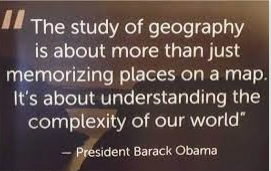
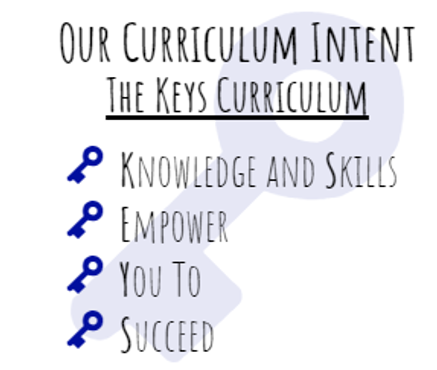
How Geography Links with Our KEYS Curriculum
Our curriculum plan sets out the aims of Geography and assures a full coverage of the National Curriculum while challenging the pupils and inspiring their curiosity!
Geography is a living, dynamic and relevant subject. It is so much more than just memorising place on a map! Our Cronton CE Curriculum KEYS – Knowledge and Skills Empower You to Succeed captures exactly what study of geography is: offering a uniquely powerful view of the world which prepares our pupils for successful future. In order to become global citizens, the children have an opportunity to grasp how the world works and how they fit into it.
Michael Palin said, “Geography is the subject which holds the key to our future.”
Building on their observations of the world in Early Years, the children in Cronton CE Primary develop their sense of place, location and scale. Through knowledge and skills, they gain a better understanding of our world. Furthermore, by the end of Year 6, they are well-equipped to fathom the big global issues and start exploring possible solutions.
 If you would like to get involved with Geography at Cronton CE (maybe you visited exciting places? You are a cartographer? You work in import-export? You did the Three Peaks Challenge?), please do not hesitate to contact the school.
If you would like to get involved with Geography at Cronton CE (maybe you visited exciting places? You are a cartographer? You work in import-export? You did the Three Peaks Challenge?), please do not hesitate to contact the school.
#geographyobsessed
Recently, we have gained the 'Primary Geography Quality Primary Mark' in Bronze which is a prestigious award that recognises and promotes quality and progress in geography leadership, curriculum development and learning and teaching in schools. This is something that we are truly proud of at Cronton CE.
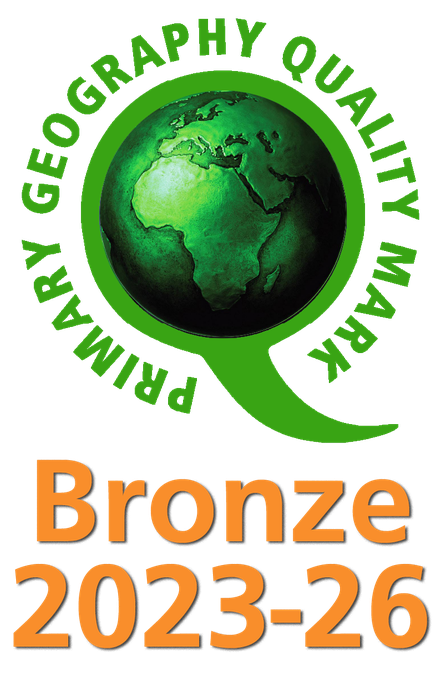
Key attributes of a geographer at Cronton
- A curiosity and fascination for the world around them
- Have a deep understanding of the world’s physical features and processes
- Have knowledge of the planet’s significant places and be able to make comparisons between them.
- Be able to collect and interpret a range of data from the world around them
- Be able to make connections between the physical and human features of our planet to other areas of the curriculum
Intent
The intention of our Geography curriculum is to develop a knowledge, skills and understanding of key geographical concepts through the study of significant geographical topics. Geography should inspire pupils’ inquisitiveness, curiosity and through the study of human and physical features, prepare them to become global citizens; aware of our changing world.
By developing contextual knowledge of the location of globally significant places and understanding the processes that shape our diverse settings and societies, the children will be equipped to recognise the significance of the change over time and spatial awareness.
The pupils will be taught how to collect, analyse and present data during their fieldwork opportunities and they will practice their maps skills by a use of a variety of atlases, maps and online resources.
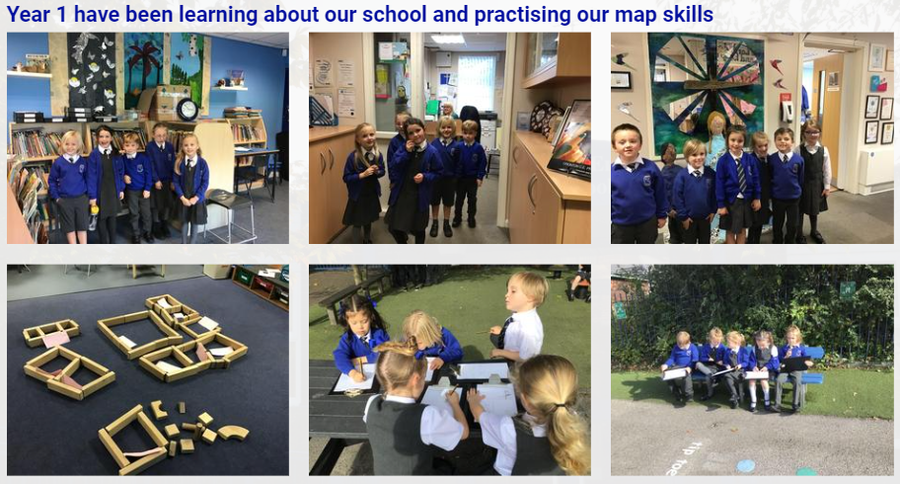
Implementation
Our Cronton Geography Curriculum has been designed in order to achieve full National Curriculum coverage and allow clear progression of knowledge and skills from EYFS to subsequently KS3 by creating diagonal, horizontal and vertical links, which allow opportunities for the pupils to revisit and build upon their previous learning hence altering their long term memory.
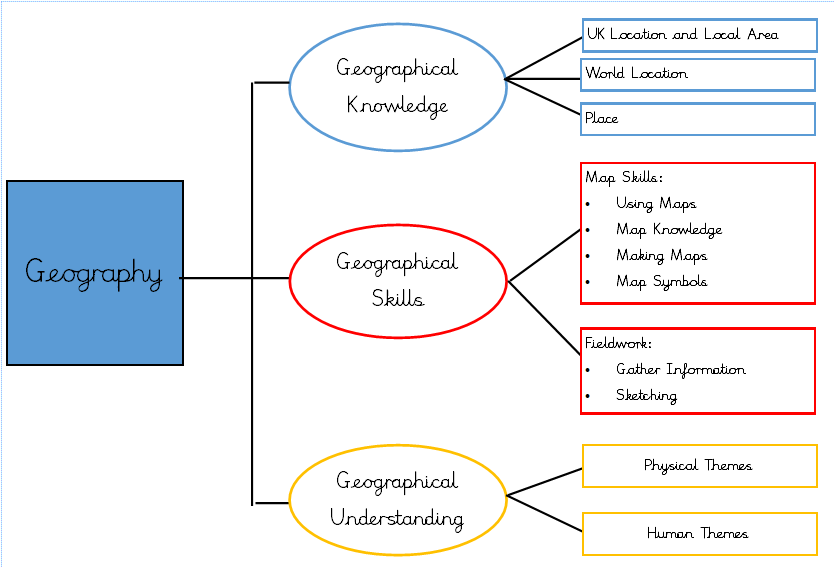
Lesson Structure
Geography lessons have a set format (apart from Fieldwork lessons) that has to be followed to maintain consistency, progression and allow for all the knowledge and skills being implemented.
This lesson structure has been designed to ensure the children learn more and remember, combining recapping with learning new knowledge and allowing children to make links. They will develop an understanding of geographical vocabulary and knowledge. They will be able to use geographical skills to learn about the world around them and be able to present their knowledge and findings in a variety of ways.


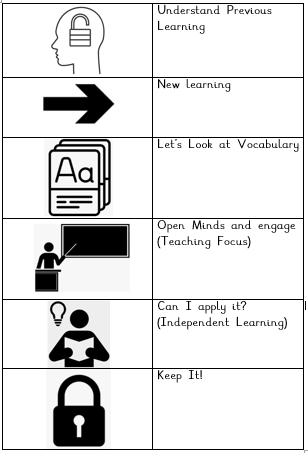
Geography Overview
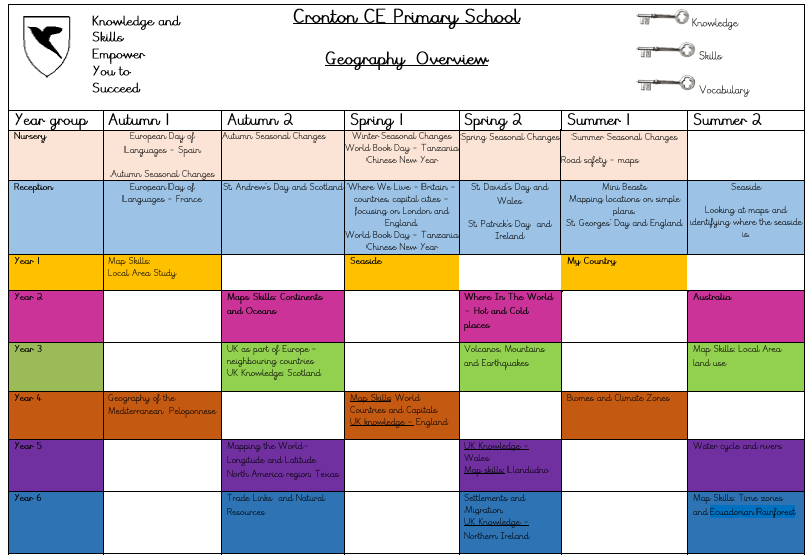
Sequencing and End Points
Overview of topics for each year group
EYFS
Children learn about other countries: France (European Day of Languages), Tanzania (World Book Day/Reading Week) and the countries that make up the UK when learning about the patron saints and celebrating their special days. They locate them on world maps and globes and discuss main features e.g. size, capital city, climate and differences in life styles at a basic level. They also explore more about Britain when we undertake a mini project on the country. They look at maps and atlases which are out in the provision. They can talk about differences between where they live and other areas in simple terms.
Year 1
Autumn: Map skills: Our School
In this unit, the pupils will continue developing their understanding of the World from EYFS and their locational knowledge through first-hand observation and use of basic specific vocabulary.
This unit is highly practical and allows the children to explore the geographical properties of their known environment (school) and some of the features present. The pupils will learn that sizes and locations can be mapped in plans and identified using aerial imagery and that the school has different areas with specific layouts and designated activity.
The children will begin to expand their knowledge by talking about the journey from their homes to the school and they will build on this in Year 2 when making comparison with a school in Australia
Spring: Seaside
Seaside is a unit of work which takes the children’s previously learned map skills and experience of fieldwork and extends it beyond the local area while still drawing on their understanding of the world and life experiences.
The children will be learning about the unique nature of Britain as an island and the surrounding seas by looking at maps. This will prepare them for learning more about their country in Summer 1 Unit My Country as they will get increasingly familiarised with the outline shape of the UK.
Through the use of maps, pictures, photographs and aerial photographs, the pupils will be taught to recognise both physical and human features of the seaside regions and the importance of coastline both for recreation and habitat for fauna and flora that needs protecting.
The children will be able to revisit their learning during History topic and the role coastline defence played in the last successful invasion of Britain by William the Conqueror. In Summer 1, they will develop their knowledge of the UK further.
Summer: My Country
In this unit, the pupils’ understanding of the UK and their local area will be developed and they will be allowed to make valuable links between their own experiences (trips, news) and ways of recording location on a map.
Serving as a short introduction, the children will begin to understand what makes each of the 4 countries of the UK special and this will be later on developed in the KS2 UK knowledge studies.
Discussing what makes our country special and unique and some of the symbols associated with it will allow the pupils to start building a deeper understanding of some of the attributes of countries and prepare them for Year 3 unit of work UK as a part of Europe.
Year 2
Autumn: Continents and Oceans
Building on their knowledge of the UK and local area from Year 1, the pupils will embark on a learning journey leading to their understanding of our planet Earth. They will begin to ask and answer questions about how people find out information about the planet. Through observation, work with maps and atlases and globes, they will be developing the global geographical context of their homes and environments. It will serve as an introduction to the geographical concepts of place and space and it will also allow the children to start thinking about scale.
This unit of work should inspire the children to want to explore the Earth and its uniqueness further and set solid foundations for their further learning about hot and cold places and Year 2 and finally, allowing them to contract their locality with a non-European country (Australia). Furthermore, their growing understanding of Earth will prepare them for more in-depth learning about each continent in KS2 and the interaction between human and physical processes in Year 6 topics Trade and Migration.
Spring: Hot and Cold places
Following their learning of Continents and oceans, the pupils will further develop their map skills and knowledge by locating the poles, the Equator and the human and physical features of different regions. They will be contrasting and comparing this with their understanding of the seasons from Year 1.
Their investigation of plants of different regions will be deepened in Summer 1 Science study of plants and they will research the desert region of Australia in Summer 2.
The children will get a chance to revisit and further develop their knowledge by studying Biomes and Climate zones in Year 4.
Summer: Australia
Following their study of our planet and some of the hot and cold places on Earth, the pupils will conclude this year’s learning and develop their world locational knowledge through studying the country of Australia and comparing the region of Thursday Island with the Widnes area.
After locating Australia on the globe and suggesting routes there from the UK, the children will have a chance of observing the differences and similarities between the two countries and understanding the historical link between them. They will deepen their knowledge of the physical and human features of Australia and the uniqueness of its nature and wildlife. In Year 4, this will be developed through the unit Biomes and Climate zones. A close investigation of the process of making some of the Australian products will lay the foundations for Year 6 study of Trade links.
Finally, the children will be able to learn about the Thursday Island, one of the Torres Strait Island and comparing its culture and way of life to their own.
Year 3
Autumn - UK as a part of Europe
This topic allows the pupils to build on their knowledge of UK and its relation to other countries. With recent political events and the Brexit situation, the children’s understanding of the UK as part of the Europe is more important than ever before.
Through the use of atlases, globes and digital maps, the children will identify and learn the difference between Great Britain, United Kingdom and the British Isles. Without a doubt, in year 3, majority of the children will have experienced holidays abroad and the scale and distances linked to their travels. Their raw experience of the world will allow them to discuss understand the relationships with other countries and will prepare them for learning about the world countries in year 4 and trade links in year 6.
Lastly, the children will be comparing the changes the UK has experienced over the last two centuries. By looking at the British Empire and remaining overseas territories, the children will get an insight into the scale of the British Empire at its golden age and, furthermore, this will help them understand the multicultural nature of the UK.
Autumn - UK Knowledge - Scotland
This topic allows the pupils to continue their learning of UK from KS1 and its countries. The pupils will be able to research Scotland using a range of both digital and paper maps and atlases and its location and significance in relation to the rest of the UK. Using their prior knowledge and well-known stereotypes, the teacher guides the children through the exploration of the most northern part of the UK and its many islands; letting the children discover and decide for themselves what makes Scotland special. During this unit of work, the children have a fantastic opportunity to use digital maps such as Digimaps for schools and Google Earth to ‘visit’ places, observe the differences between different locations and report back on their findings. Doing so, they will begin to recognise the differences when using maps of different scales.
The study of physical features will serve as an introduction to the topic Volcanoes, Mountains and Earthquakes studied later on in the year. Research of significant cities and what makes them important will lay base for the students’ learning about trade, natural resources and global links in Year 6, where it will be revisited and build upon.
Spring: Volcanoes, Mountains and Earthquakes
This unit of work continues to develop the pupils’ understanding of landscape and physical features of our planet and allows them to further investigate how some of these features are formed, processes related to these changes and most importantly, where in the world these occur.
Building on their previous study of Rocks in Science in Spring, the children will be using atlases and online maps to identify some of the world’s most prominent mountains, volcanos and areas well-known for volcanic activity and earthquakes. By revisiting their study of Scotland from Autumn, the children will learn to differentiate between a dormant and an active volcano and they will also research the positive and negative impact a volcanic eruption can have on human lives.
This unit is concluded by briefly explaining earthquakes and tsunamis with focus on the effect on people in the world.
The pupils will continue to develop their awareness of the world and its countries in Year 4 and they will further their understanding of the geology of the Earth in Year 5 Science in Autumn.
Summer: Local Area Land Use
This last unit of Geography work for Year 3 links is mainly practical with many opportunities for fieldwork and map skills and aims to build upon the Year 1 Local area study unit of work by teaching and utilising KS2 Map skills. The unit comes after History topic in Summer 1 (History of Cronton), in which the children will have understood the significance and history of Cronton as a settlement and learned about some of the key topographical features of Cronton.
In this unit, the pupils will be merging their history knowledge with the locational knowledge and developing those through observation of land is use in local area. The pupils will begin to discuss the reasons and suitability of a location for land uses and they will learn to differentiate between rural and urban areas, all through the use of OS maps, making of their own sketch maps and gathering evidence in the field. Revisiting their UK Knowledge: Scotland unit from Autumn, the children will compare the land use in Cronton and Edinburgh. In their assessment lesson, they will have a brilliant opportunity to compare historical and present day maps and observe the urban growth.
This unit of work lays foundations for Year 6 topic Settlements and Migration, in which the pupils will be able to extend their understanding of land use beyond the local area.
Year 4
Autumn: Geography of the Mediterranean
This unit of work continues to develop the pupils’ knowledge of Europe and some of its geographical areas and features using atlases, maps and research.
Building on their study of the Romans in Year 3 History, the pupils will develop their understanding of the Mediterranean sea’s significance and characteristics, allowing them to build solid foundations for their Spring topic Map Skills: World Countries and Capitals. Through the study geographical features of the Mediterranean region, the children will naturally progress onto the study of Biomes and Climate Zones in their summer topic.
Through the study of a small area of the Peloponnese Peninsula, the children can discover both the physical and human characteristics of Greece and make links between their experiences and the new knowledge. In Spring term during their study of UK Knowledge – England, they will make comparisons between the Peloponnese and East England regions.
In Year 6, they will be continuing to deepen their knowledge of the area through the study of migration and the role the Mediterranean Sea played and still plays in it.
Spring: Map Skills: World Countries and Capitals
In this sequence of lessons, the children will be extending their knowledge of maps and places through learning about world countries and capitals. At the same time, they will be introduced to some of the complexities of human geography with opportunities to make meaningful comparisons and to reveal hidden patterns.
Having previously explored the UK’s place in Europe and its neighbouring countries in Year 3 in both Geography and History, the children will embark on an explorative journey of the world, discussing the concepts of countries and regions. They will learn what bounds a country together and learn to recognise symbols which mark a country’s identity.
This unit will allow the children to frequently use the world map, which will allow for a smooth transition into their study of biomes and climate zones later in Year 4. At the end, the pupils will learn about different ways countries work together in political associations and some of the associations the UK is a part of. Finding out how nations can cooperate with each other will raise questions about underlying values and the children can recognise and discuss how the British Values fit into the beliefs and principles of The EU, Commonwealth and UN. Moreover, their understanding of the ways these alliances can combat some global environmental and security issues prepares the children to take their place in the world as global citizens.
UK Knowledge - England
Building on their knowledge of the UK as part of Europe from Year 3, the pupils will continue their studying of the 4 countries of UK. Having learned about Scotland in Year 3, the pupils will be guided to build their knowledge of England’s key topographical features and land use patterns.
Through the study of the human and physical features of the country they live in, they will be able to make an effective comparison between the previously studied region of Peloponnese and the region of East England and its counties. The focus on East England is not incidental; it draws on the children’s previous experience with it when learning about the Romans in Year 3 and Boudicca, and it will give them a chance to observe how the region changed over time by learning about the Anglo-Saxons’ invasions in History in the second half of the Spring term.
The pupils’ learning will be continued in Year 5 by studying Wales.
Summer: Biomes and Climate Zones
Continuing the study of different habitats from Year 2, the pupils will further develop their understanding of what biomes are and what makes them the unique and protection-worth part of our world. They will also start to recognise how are biomes, climate zones and vegetation belts linked and the changes these face due to the climate change and human activity; this will be built upon in Environmental Science unit in Summer 2 – Destructions of Habitats.
By an in-depth study and research of each of the biomes, the children will be able to identify some of the similarities and differences of the same biome in different location (steppes, prairies and savannahs) while revisiting the Map Skills unit of World Countries and Capitals and having and opportunity to develop their locational knowledge of the world.
By the end of the unit, the pupils will be able to explain what a biome is and name some examples, including the fauna and flora specific to these. They will know that biomes cover very large areas and are the results of different climate conditions. This will provide a solid foundation for Year 5 Mapping the World unit and the link to the lines of latitude and further on, in Year 6, the pupils will have an opportunity to study in depth the Amazon rainforest and some of the global issues linked with it.
Year 5
Autumn: Mapping the World – longitude and Latitude
North America region – Texas
Continuing to deepen their knowledge and understanding of our world, the pupils will be investigating why and how is our Earth mapped. After having gained insight into the link between climate zones and lines of latitude, the children will be practising their map skills using atlases and maps to locate countries and basic coordinates. Building upon their knowledge of Continents and Oceans from Year 2, the pupils will then move onto the study of a region in North America: Texas. They will be able to revisit their learning of Biomes from Year 4 through careful investigation of Texas’ biomes and will be making comparisons to their own locality and its human and physical features.
This unit serves as a consolidation of some of the key geographical concepts that the pupils learn in KS1 and LKS2 and at the same time allows the children to begin gaining understanding into how are continents and countries connected, which they will develop in Year 6 when looking at Trade links and Settlements and Migration.
Spring: UK Knowledge: Wales and Map Skills: Llandudno
This unit of work builds on the pupils’ previous knowledge from KS1 of UK’s four countries and the Seaside unit in Year 1 by extending further their knowledge of coastlines and how are coastlines formed. Continuing their learning of the UK’s locational knowledge from Year 3 (Scotland) and Year 4 (England), they will research in more depth Wales. This will allow them to prepare for their residential trip to Llandudno as a seaside resort and coastal town and while there, using fieldwork and map skills to make sketches, create maps and recognise human and physical features as identified on OS maps. In use will be put the pupils’ previously obtained skills and knowledge of land use patterns from Year.
This unit will also serve well as a comparison to previously studied region in North America (Texas) in Autumn in relations to habitats and biomes.
By learning about the human and physical features of Wales and what makes it special, the pupils will get a deeper understanding of some of the historical changes linked to the country and its industry and research of the Dinorwig power station provides a link to environmental science and natural resources unit in Year 6. Finally, a year later, the children will conclude their learning of the 4 countries of the UK by learning about Northern Ireland.
Summer: Water Cycle and Rivers
In this unit, the pupils will build on their previous study of Water cycle in Year 4 Science Unit States of Matter by understanding all the processes involved in the way water circulates on our planet and further linking their experiences to this. They will also be introduced to the idea that water is a key natural resource and will understand its importance in our lives, which will prepare them for Year 6 Unit Trade Links and Natural Resources and later on, Migration. They will be able to describe some global initiatives to improve living conditions and supply of water.
Using all their acquired knowledge from UK Knowledge Units (Y3 Scotland, Y4 England, Y5 Wales), the pupils will be extending their knowledge of rivers by locating the world’s longest rivers on a map. They will discuss the importance of rivers in people’s lives and compare that to historical significance, building on their study of Ancient Egyptians in Year 4 and local history unit Crossing the Mersey in Year 5. Learning to identify features of a river and how it shapes the land, they will build a good foundation for further study of the Amazon Rainforest in Year 6 and the Amazon river.
Year 6
Autumn - Trade links and Natural Resources
This explorative unit of work introduces the students to natural resources by highlighting minerals and energy, food and water. In order to understand modern world, the children will learn and realise that resources are unevenly distributed geographically. The increasing demand for natural resources also links to the study of sustainability and finding a way to live in harmony with the planet that supports us, which is a topic the children will further build on in Spring 1 study of Environmental Science unit of work.
The children will also be introduced to the term ‘economic activity’ as one of the dynamics underpinning modern world. Through evaluating the journey an object has to make in order to arrive to their home/classroom and looking at globalisation, the student will identify the transformation our world has made from people depending on themselves to create resources for survival to different areas being specialised in certain economic activity and how those are linked to other areas.
Spring - Settlements and Migration
This unit of work continues to develop the pupils’ understanding of globalisation from Trade Links and Natural Resources unit in Autumn 2. It also builds on Local area studies in Year 3 and Year 6 and further develops the pupils’ comprehension of how population is spread in the world.
By investigating settlement patterns and using atlases and small-scale maps to locate large cities, the children will continue to make links between natural resources and population.
They will learn about the reasons why people migrate and the difference between a voluntary and forced migration and they will have a chance to research some of the most prominent migrations that had shaped our world as we know it; making links from history and local studies.
This unit will also touch up on current issue of refugees and the impact various factors can have on people.
Spring- UK Knowledge: Ireland (Map Skills)
This unit of work builds on the pupils’ previous knowledge from KS2 of UK’s four countries and concludes it by learning about Northern Ireland. It clearly links to the research of the history of the local area (Liverpool) and its links with Ireland.
By learning about the human and physical features of Northern Ireland, its links to the Republic of Ireland and what makes it special, the pupils will get a deeper understanding of some of the historical changes linked to the country and its industry. They will be able to apply their knowledge of settlement patterns and migration to understand the links between Northern Ireland and North West England.
Summer: Map Skills: Time Zones and Ecuador rainforest
This unit of work brings together everything the pupils have learned in KS1 and KS2 across Geography and other subjects. It allows the pupils to develop their map skills through understanding of time zones and revisiting Year 5 unit of Longitude and Latitude and advance their place knowledge and awareness of world countries by focusing on a not so obvious region of South America, Ecuador.
By locating and describing the key physical features of the continent od South America, the pupils will realise the dominance of the Amazon and the rainforest that covers the Amazon basin. Through the study of geography of Ecuador, they will be able to break some of the stereotypes and misconceptions about South America, discover the uniqueness of the country’s physical and human features and they will also revisit their previous Geography topic of migration, looking at ethnicities present in Ecuador.
Finally, the children will have an opportunity to understand the importance and need for protection of the rainforests.
This Unit not only allows to consolidate previous learning but also provides a chance to discuss some of the global issues linked to non-renewable natural resources, which are usually associated with the more obvious names (Amazon rainforest, Brazil), historical and political connotations and the environmental impact these relationships have on our planet.



